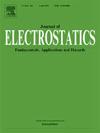水循环介质阻挡放电等离子体反应器快速降解亚甲基蓝
IF 2.1
4区 工程技术
Q3 ENGINEERING, ELECTRICAL & ELECTRONIC
引用次数: 0
摘要
采用介质阻挡放电(DBD)等离子体反应器对水中亚甲基蓝(MB, C16H18ClN3S)进行了高效降解。平板- dbd系统产生的空气等离子体通过微起泡器引入到MB溶液中。尽管等离子体中形成的活性物质寿命短,但它们与水接触后能有效地分解污染物。本研究考察了空气流速、初始溶液浓度、臭氧生成和能量生成等因素对MB降解的影响。实验结果表明,该等离子体反应器能有效地降解MB,并通过平板- dbd等离子体模块和300-L循环处理系统优化了提高反应速率的机制。在初始MB浓度为5 mg/L的条件下,从1000 L池到300 L反应器的循环时间为50 min, 60 min后降解率达到97.5%。降解MB的能量产率为22.5 g/kWh,臭氧产率为3.9 g/h。本研究提出了一种潜在的MB溶液快速降解途径。该反应器设计在印染废水和工业过程中降解甲基溴方面显示出良好的应用潜力。本文章由计算机程序翻译,如有差异,请以英文原文为准。
Rapid degradation of methylene blue using a dielectric barrier discharge plasma reactor with a water circulation system
Methylene blue (MB, C16H18ClN3S) in water was efficiently degraded using a dielectric barrier discharge (DBD) plasma reactor. The air plasma generated by the flat-DBD system was introduced into the MB solution through a micro-bubbler. Despite the short lifetimes of the active species formed in plasma, they effectively decomposed contaminants upon contact with water. This study investigated the influence of various factors, including air flow rate, initial solution concentration, ozone production, and energy yield, on MB degradation. The results showed that the proposed plasma reactor could efficiently degrade MB. Furthermore, a mechanism to enhance the reaction rate was optimized using the flat-DBD plasma module and a 300-L circulating treatment system. With an initial MB concentration of 5 mg/L, one cycle from the 1000-L tank to the 300-L reactor took 50 min, achieving a 97.5 % degradation rate after 60 min. The energy yield for MB degradation was 22.5 g/kWh, and ozone production reached 3.9 g/h. A potential rapid degradation pathway for the MB solution is proposed in this study. This reactor design shows promising potential for applications related to the degradation of MB in dyeing wastewater and industrial processes.
求助全文
通过发布文献求助,成功后即可免费获取论文全文。
去求助
来源期刊

Journal of Electrostatics
工程技术-工程:电子与电气
CiteScore
4.00
自引率
11.10%
发文量
81
审稿时长
49 days
期刊介绍:
The Journal of Electrostatics is the leading forum for publishing research findings that advance knowledge in the field of electrostatics. We invite submissions in the following areas:
Electrostatic charge separation processes.
Electrostatic manipulation of particles, droplets, and biological cells.
Electrostatically driven or controlled fluid flow.
Electrostatics in the gas phase.
 求助内容:
求助内容: 应助结果提醒方式:
应助结果提醒方式:


